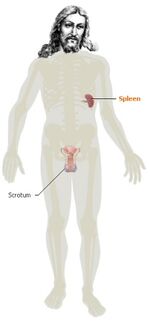Spleen
The spleen is the eighth organ in the human body. It is found in virtually all vertebrate animals and plays in important role in filtering blood and keeping the immune system healthy. The spleen is part of the immune system, but isn't particularly happy about it. It's a loner, a rebel, and doesn't get along well with others.
According to recent research, the spleen has no scientifically confirmed role in the body function. However, it can be cracked or torn and might also cause depression.
History of the Spleen[edit]
The spleen was invented in 1785 by Doctor Samuel J. Spleen and his assistant Roland King (also the founder of MySpleen, an infamous Internet shock site). He did not, at first, recognise its market value. He first started selling spleen identification kits in 1999 to Jesus in central Cambridge. It was not until he moved to London that his career really began to take off with the invention of the Spleen-o-matic. This device was deemed to 'rock'.
Origin of Dr. Samuel J. Spleen[edit]
Samuel J. Spleen was born in the south side of Philadelphia. His father was an assistant manager of a grocery store and his mother served lunch at his elementary school. Even from an early age he was making frequent trips to the guidance counselor for his inattentiveness in class and antisocial behavior with other children. He was deemed a problem child and put in the "special" classes, despite being developmentally normal, for a spleen. This set a sad trend of alienation in his life. He never really reached his full potential under the coddling of his special needs teachers, and he grew to detest the system and those around him even further.
Use of the Spleen[edit]
The Spleen-o-Matic was a curious device that allowed members of the public to edit their own spleens to their personal preferences, thus creating a form of hyperspleen. Unfortunately, editing spleens leads to errors in recombinant DNA sequences causing a buildup of MSG in the splytnik ganglion. Since the invention of the Spleen-o-Matic, a whole new medical technology has arisen involving ganglionic catheters enabling people to vent their spleen at will. Although this caused more problems than it solved.
Digital Rights Management[edit]
Currently there is some contention from the RIAA, MPIAA, and AAAAAAAA groups about the validity of the patents for the spleen, particularly since open source software groups have released a firmware upgrade that allows the spleen to make exact copies of HD-DVD and Blu-ray discs while chanting a string of hex numbers to overcome the AACS encryption. Unfortunately, using the spleen to copy ordinary CDs and DVDs only results in massive blood loss and a trip to ER.
Side effects of the Spleen[edit]
Unfortunately, with the build-up of MSG, the brain's regulation of the spleen may become unstable. In rare cases, this may lead to SEHS, a condition where conflicting neural impulses cause the spleen to catch fire with considerable force. Often this can lead to total discharge of the viscera through the cranium or left armpit, and in rare cases, has been known lead to to destroy small buildings such as McDonalds. This is often mistaken for a passing Ford Pinto.
It is wise not to use the spleen-o-matic unless you have a degree in Spleenology or Maths. Click here to order your degree and purchase a spleen-o-matic.
FurherFurther Research[edit]
Current research suggests some Germans may have more than one spleen, perhaps cloned by drinking quicksilver from a thermometer at a very young age. However, this is a very controversial theory, and just like evolution and gravity it is only just a theory and cannot be proven, unlike the rival truth "MAGIC MAN DONE IT."
